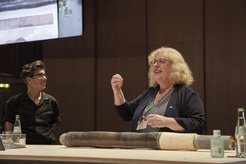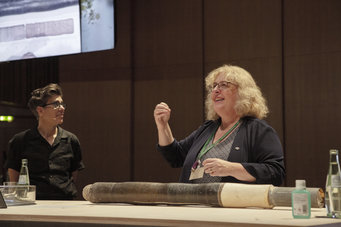Anthropocene Working Group proposes Crawford Lake as GSSP candidate site of the
Anthropocene series
On 11 July, in a joint press conference with the Max Planck Society (MPG), the Anthropocene Working Group (AWG) announced Crawford Lake, Canada as the proposed Global boundary Stratotype Section and Point (GSSP) candidate site of the Anthropocene series. Selecting Crawford Lake marks a significant step in the AWG’s effort to test the geological validity of the Anthropocene hypothesis and towards the scientific, and thereby also political and social recognition of the scale and severity of planetary transformation processes unleashed by industrialized humanity

A prerequisite for the recognition of a new unit of the chronostratigraphic time scale is the identification and description of a geological profile indicating the onset of planetary-scale change, a GSSP. Since 2019, the AWG has coordinated a systematic study at twelve different sites across the globe, representing different environmental archives, for geological evidence of the proposed Anthropocene series in strata and its equivalent in time the Anthropocene epoch. After months of deliberations and a series of votings, the AWG now proposes a sediment core drilled from the bottom of Crawford Lake (Ontario, Canada) as GSSP candidate site of the Anthropocene series.
The research findings of Crawford Lake provide strong evidence for the AWG’s hypothesis that the unprecedented increase in industrial and socioeconomic activity of the Great Acceleration around the mid-twentieth century has caused alterations to the Earth System on a scale that terminated ~11,700 years of largely stable Holocene conditions and marks the beginning of a new Earth epoch.
The human-made markers such as artificial radionuclides, combustion particles, changed biotic populations, or organic pollutants found in sedimentary layers at the bottom of Crawford Lake are not only witness to the longevity and scale of human-caused planetary change at an annual resolution. The history of the lake is also emblematic of the socio-economic dynamics and violent histories that continue to drive the Anthropocene. The annually resolved layers of Crawford Lake’s geological record cover centuries of changes to the local environment, including the botanical impact of small-scale agriculture practiced by Indigenous communities in the thirteenth to fifteenth centuries and the logging and milling that took place with the arrival of European colonial settlers in the nineteenth century. Yet the most fundamental change occurred during the mid-twentieth century with rapid industrial expansion in the region indicative of global trends, and coinciding with early fallout from atomic and thermonuclear weapons testing.
The full proposal of the AWG needs to be agreed and voted on by the AWG before it is presented to the Subcommission on Quaternary Stratigraphy (SQS) later in 2023. Members of the SQS will need to vote on the proposal and if they agree with a 60% majority it will then pass on to the International Commission on Stratigraphy (ICS) who will also have to vote and agree with a 60% majority for the proposal to move onwards to the International Union of Geological sciences (IUGS) for consideration of final ratification. There is no guarantee following AWG submission to the SQS the proposal will indeed succeed. However, the results of the AWG’s multi-year study mark both a substantial step forward in the formalization process of the Anthropocene epoch and constitute a major scientific achievement in recognizing the fundamental impact that human activities have inflicted on the planet.
The AWG’s announcement also marks the culmination point of a longstanding cooperation between the AWG, Haus der Kulturen der Welt (HKW, Berlin), and the Max Planck Institute for the History of Science (MPIWG, Berlin). Since 2013 the AWG’s work has been supported and further contextualized by the HKW and MPIWG in a pioneering transdisciplinarycollaboration. Through the research platform and international network Anthropocene Curriculum as well as a series of public projects that included a Core Reading of the Crawford Lake sediments in the joint program Evidence & Experiment, the project develops novel forms of collaborative knowledge production for the Anthropocene.
Read Further
Browse the selection of news artilces about the GSSP site below.
English Media
A
- ABC - Crawford Lake in Canada voted 'golden spike' site to determine Anthropocene epoch
- Axios - Scientists say Canadian lake marks start of the Anthropocene
C
- Canadian Geographic - The Anthropocene is here — and tiny Crawford Lake has been chosen as the global ground zero
- CBC - Canada's Crawford Lake chosen as 'golden spike' to mark proposed new epoch
- CNN - Scientists say they’ve found a site that marks a new chapter in Earth’s history
- The Conversation - A Canadian lake holds the key to the beginning of the Anthropocene, a new geological epoch
D
F
- Forbes - What Is The Anthropocene Epoch—And Why Do Scientists Think A Lake In Suburban Canada Defines It?
G
- The Guardian - Canadian lake chosen to represent start of Anthropocene
N
- Nature - This quiet lake could mark the start of a new Anthropocene epoch
- New York Times - The Human Age Has a New Symbol. It’s a Record of Bomb Tests and Fossil Fuels.
- NPR - Scientists say new epoch marked by human impact — the Anthropocene — began in 1950s
S
T
W
German Media
A
- ARD Alpha - Erde im neuen "Zeitalter des Menschen"
B
- Berliner Zeitung - Anthropozän: Dieser Ort soll den Anbruch eines neuen Erdzeitalters belegen
- Bild der Wissenschaft - Ein Referenzpunkt für das Anthropozän
F
K
- Klimareporter - Der goldene Nagel im Crawford Lake
M
S
- Scinexx - Ein „Golden Spike“ für das Anthropozän
- Der Spiegel - »Wo Sie auch hinschauen – der Mensch hat die Welt verändert«
- SRF - Anthropozän: Stecken wir schon in einem neuen Erdzeitalter? (Podcast)
